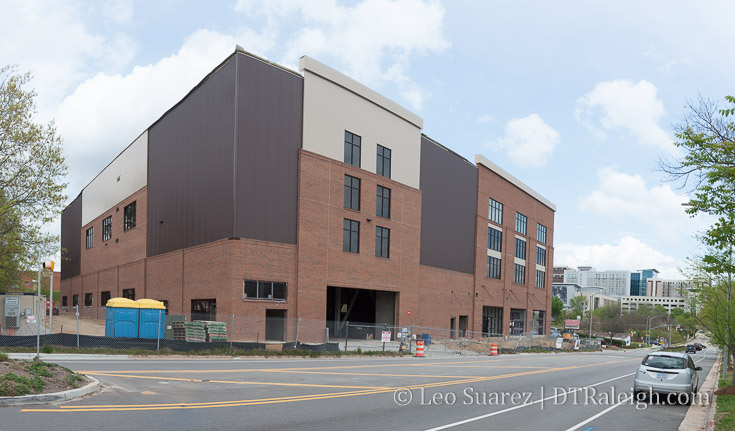
The storage facility being built on West South Street.
It could be worse.

The storage facility being built on West South Street.
It could be worse.
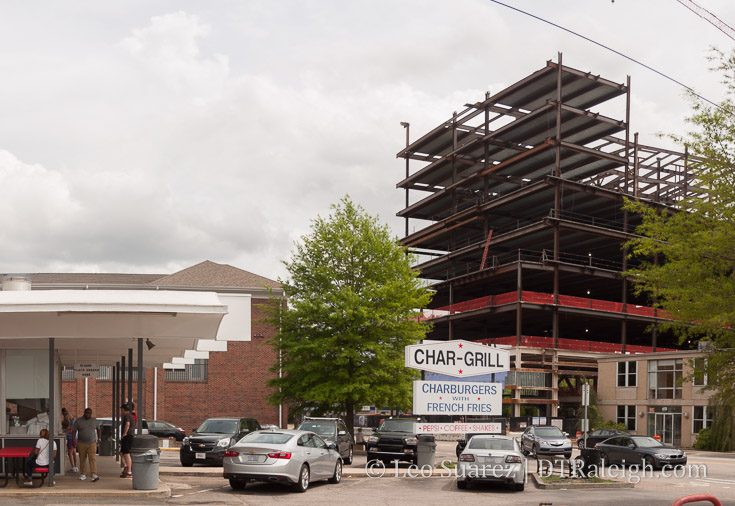
Char-Grill on Hillsborough Street. April 2018.
I’ve been enjoying the new feel on Hillsborough Street with all the steel going up at One Glenwood. This block will hopefully see an increase in pedestrian activity and pump more lunch seekers on the southern end of Glenwood South.
The former empty lot to tower conversion is some really great infill for downtown Raleigh and it’s exciting to see it come along. Get out and walk that area if you can soon!

The photo above shows the site of Peace (unofficially Smokey Hollow), the 12-story apartment building planned at the corner of Peace and West Streets. Foundation work has been going strong for awhile and recently, I noticed the foundation for a tower crane pop up.
Seems like we’ll be seeing this project rise up soon.
With a ribbon cutting date set (April 30 at 9:30 am by the way) for Raleigh Union Station, it is never too early to take a look at a new project nearby. For years, plans have been light about integrating buses near Union Station that there hasn’t been much to post about. However, within Wake Transit’s Fiscal Year 2019 Draft Plan, details arise about the bus facility planned next to our newest train station.
A hat tip to a long-time reader for pointing me to the rendering above, showing what such a bus station could look like.
Funded by the half-cent sales tax passed in 2016, FY2019 will allocate $700K towards design of this facility. This is in addition to $2.7 million for FY2018.
Located across the street from The Dillon and pretty much the only adjacent property to Union Station, I think it should not be a surprise that this building is set up for some major changes in the coming years.
The rendering, which readers should take with a grain of salt and is nothing close to final, suggests what a mixed-use bus facility could look like.
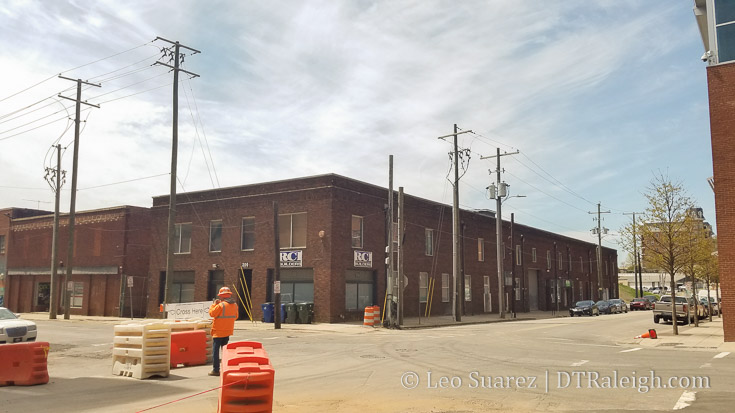
The Triangle Transit Authority already owns the buildings. With a zoning of DX-12, (Downtown Mixed use, 12-story height limit) I imagine a public-private partnership is in order to put some office, for example, over transit in this area.
I’d like to think too that The Dillon and nearby Citrix have also paved the way for how warehouse development can happen in the Warehouse District. There’s no reason this facility could not attempt to keep some of the character that exists here.
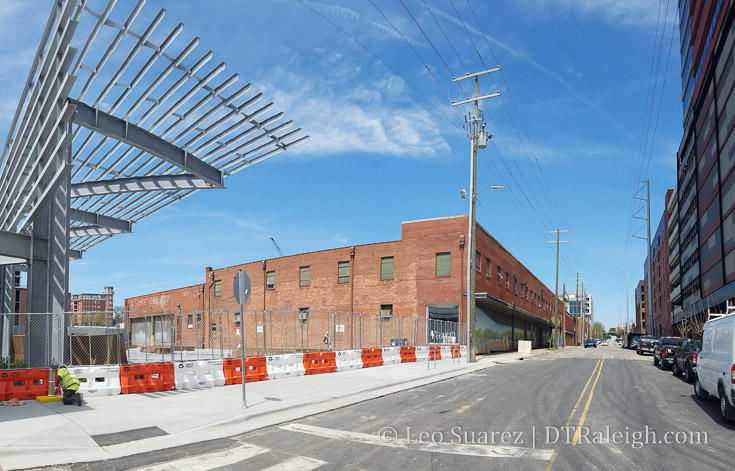
This area will truly be our city’s transit epicenter and as the Wake Transit plan comes together through 2027, I see nothing but increased pedestrian counts here.
Coupled with all the changes coming to West Street (here and here) overall and how planners working on Dix Park want to connect downtown, these are all huge moving pieces that could really click in the future to make a great western side of downtown Raleigh.
Municipography is a summary of current issues going through the Raleigh City Council and other municipal departments in the city. The point is to try to deliver any video, photos, and text associated with the discussions happening at City Hall or elsewhere. Since this is a downtown Raleigh blog, the focus is on the center of the city.
I recommend email readers click through to the website to see the embedded video.
Discussion continues over a potential new development on Peace Street where a developer wants to build a boutique hotel. 615 West Peace Street, mentioned on the blog before, is zoned for 3-stories but after an initial application of 5-stories, negotiation with neighbors have dropped it to 4.
Shown above is the public hearing around this issue that took place this week and I think it’s important for readers to watch. It gives you a sense of the council on density and rezoning cases.
On a positive note, I actually do think there is a sense of approving this but the council seemed to get into the weeds about the rooftop bar. A lot of the discussion focused on what can be done on a roof and some feel that a 4-story height limit in addition to a rooftop deck is basically the same as a 5-story building.
Here are the highlights if you don’t want to watch the whole thing:
For me, I find myself repeating myself when I say that I want the council to focus on bigger issues but instead are diving into the weeds of each case that’s presented in front of them. I don’t want to go off here but it just seems that if a council meeting wants to spend time on what the railings are going to look like, something is wrong.
Watch the video and decide for yourself. The conversation continues on April 17 as the council voted 7-1 (Stewart opposing) to delay a decision by two weeks.
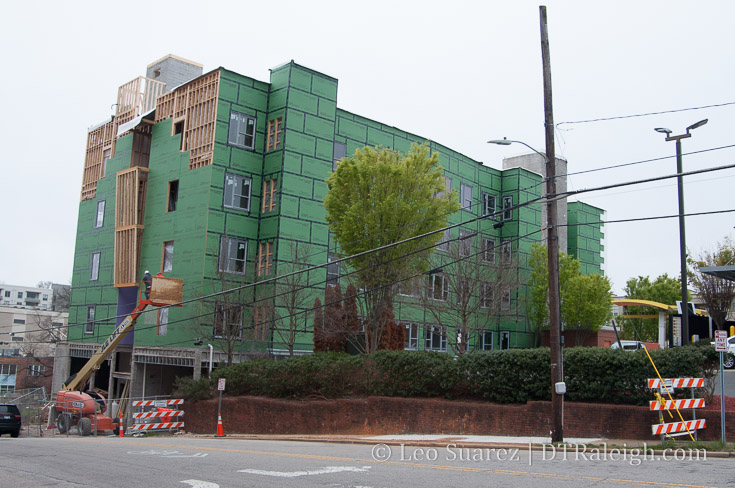
Here’s the latest update on Boylan Flats. The project is still kind of a mystery with no confirmed report of what this 48-unit building will be. The strongest rumor is it is an extended-stay hotel.
That could be the case as there will only be 37 parking spaces, according to the site plan, which is below the residential requirement but above the hotel requirement.
I also think those northern units with the “out-the-window ordering” feature integrated with the McDonald’s drive-thru would not appeal to future condo owners.
We’ll wait and see.
[UPDATE: Mystery solved.]
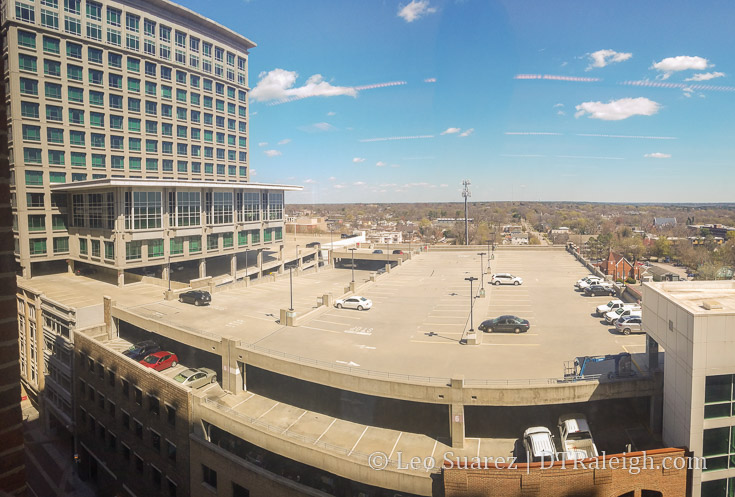
A month or two ago, thousands of visitors descended on downtown Raleigh for a convention at the Raleigh Convention Center. Some may have been in hotels nearby but most were driving into town and were looking for parking. The decks underneath the Marriott hotel and city plaza were open and cars filled them as usual.
The problem? No one, or no technology, was there that day to tell those visitors that those areas were for monthly pass holders held by office tenants nearby.
This breakdown in the system that day caused delays and frustrations by office workers. I saw this in my officemates that drove (I happened to walk in that day) and showed up stressed because unlike a typical day, the parking decks were slammed.
It didn’t help that the convention kicked off with a 7 am breakfast that hundreds (thousands?) showed up for, beating the office workers in that day.
This is one example of many showing that our parking supply is reaching a maximum and headaches like this give downtown a negative image to a certain degree.
It’s being worked on though. The feedback is loud and clear.
Parking in downtown is not as easy as parking in the suburbs.
There’s part “duh” to that statement, said by a lot of downtown businesses and office tenants. Some people don’t mind but it helps when their company is large and commands hundreds of dedicated spaces for themselves, whether they use it or not. (see above photo)
I’ve met folks who don’t come to downtown because they hate the parking experience. I’ve also heard of downtown businesses who don’t consider opening in downtown because of the parking experience. Yet, the amount of downtown residents, businesses, and retail has been going up so something is working.
What we may be facing soon is the large build-out of parking decks in the 1990s and 2000s has now reached near capacity. I’m starting to think that the decks along Wilmington Street (City Center deck, Moore Square Station Deck, etc) were actually a major asset in recruiting business and fueling the revitalization of the 2000s and 2010s.
What I LOVE about Raleigh is that we are at least asking the question, “Is this the downtown Raleigh that we want to keep building?”
I feel that the city is 100% acknowledging that structured parking is expensive. In my opinion, I feel the city should be a partner in downtown parking management rather than being in the business of it.
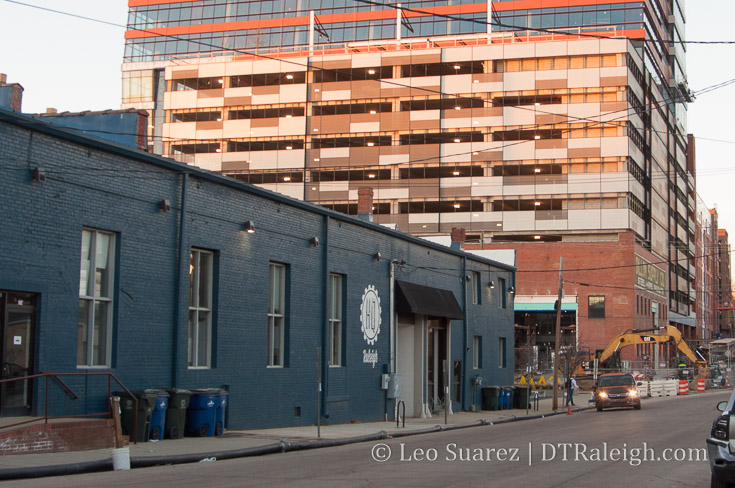
For example, the city is leasing spaces in the 1,000+ space deck at The Dillon in order to support the upcoming Raleigh Union Station. Rather than build it themselves, we have a public-private partnership to help spread out the cost and leave the city flexible in the future.
Instead of the city building more parking decks, offering alternatives to get in and out of downtown must be explored.
When it comes to bike accessibility, more bike lanes have been placed over the past few years. This summer, we should see Raleigh bikeshare up and running. Bike corrals have been popping up. We’re also experimenting with cycle tracks.
Frequent mass transit is the eventual goal to take pressure off the parking problems in downtown Raleigh. With the 10-year transit plan only really starting in 2017, we’ve got a long way to go.
So how do you implement short-term solutions until bus-rapid transit, frequent buses, and a commuter-rail line are running in 2027?
The TBJ (subscription required) published an article about this very thing. The headaches caused by a thin supply of parking are forcing those behind-the-scenes to come up with new ideas.
Everything from reducing parking space sizes to paying businesses for unused spaces is being considered.
I’m going to pick on Red Hat, their parking deck is shown in my photo at the top, but the same applies to other companies in downtown Raleigh as well. I can easily guess that the fine folks there tend to work remote on Fridays as seen from their lack of cars in their deck every Friday.
It gets me thinking that one big short-term solution is not exactly to tackle the raw parking supply issue but rather the parking supply USE issue.
We have to start dropping the mentally that spaces are for a specific company or use. Spaces are for cars to sit in. What the person then does afterward doesn’t matter.
I’m not sure what that might look like but when you take into consideration that structured parking costs around $20,000 per space, you can see real savings here spending money on innovative solutions rather than doing the same old same old.
I think this will be important to follow and I’m hoping that we can get it right. A mishandling of this issue may slow downtown development momentum as transit is coming but still a ways out.
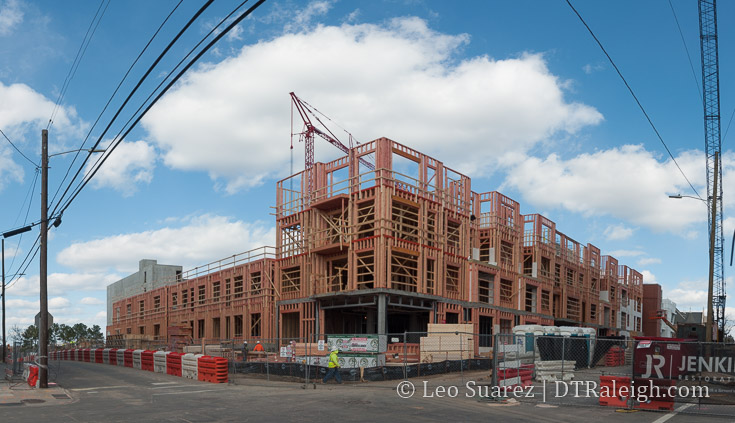
It has been a year since the 2017 fire and things are still not cleaned up on Jones Street.
The Link apartments seem back to normal on the outside and West Street is now open. The Metropolitan, shown above, is rising up again but across the street, there’s still lots of work to be done. The Quorum Center seems to be slowly replacing the entire facade that faces Jones and new brickwork is underway.
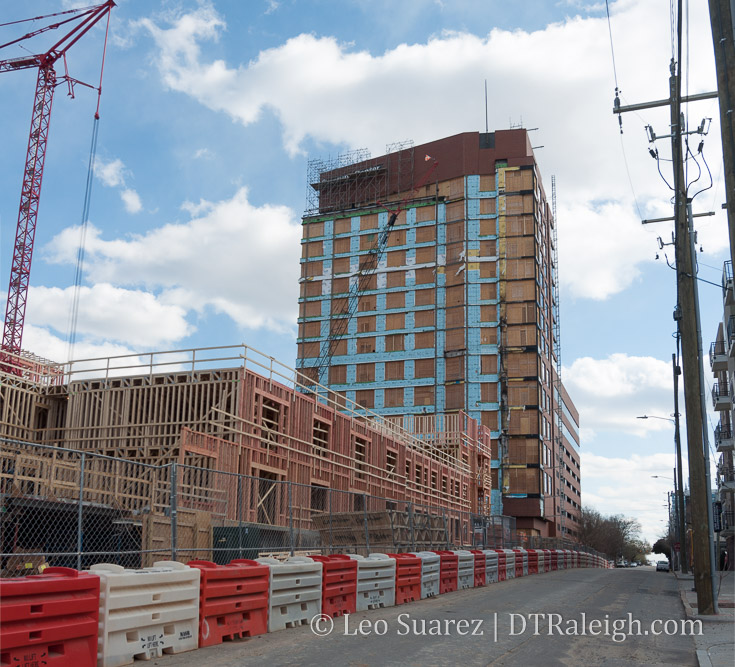
I can’t pretend to feel what those residents are going through still but I will toast it up tonight and hope that Spring 2018 brings leaves AND residents back to Jones Street.